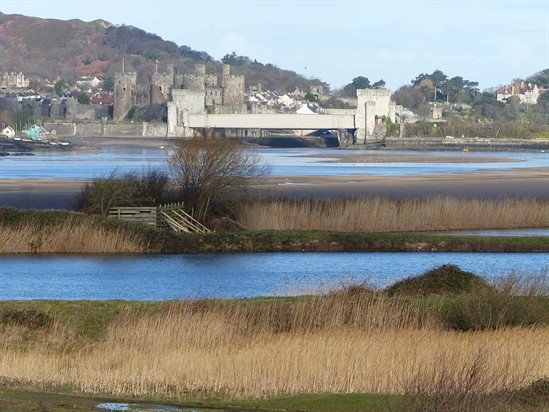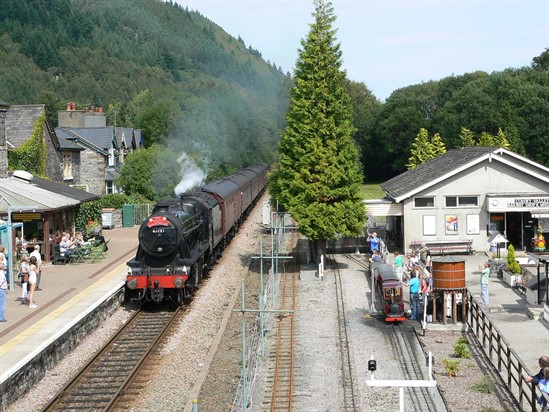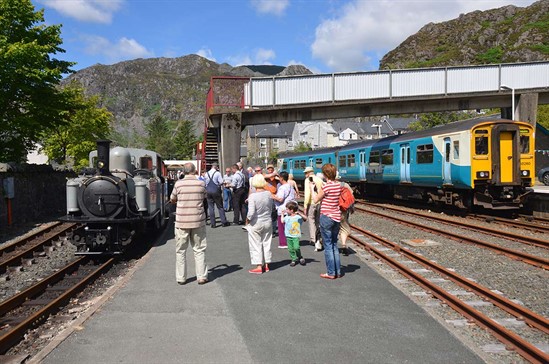Posted on 11/10/2017 by David
This summer we were lucky enough to take a trip down the Conwy Valley from Llandudno to Blaenau Ffestiniog on the Conwy Valley Railway. Part of the National Rail Network, this daily service is run by Arriva Trains Wales and runs all year round.
This rural branch line was developed as a means of transporting people and goods up and down the valley in the nineteenth century. Visitors were ferried up to the popular resorts of Trefriw (then famous for its spa) and Betws-y-Coed (then what can only be described as a hipster artists' retreat), and roof tiles from the slate capital of the world, Blaenau Ffestiniog, were transported to the coast for export.
The Conwy Valley Railway's industrial importance has long since waned but it is still one of the best methods of travelling between the coast and central Snowdonia for visitors and local alike.
At 27 miles in length, it has 13 stops from start to finish (a mixture of standard and request stops); 47 curves, each revealing a landscape more dramatic than the last; and the the longest single track railway tunnel in the UK, a staggering 2.2 miles long.
The coast
Our trip began at Llandudno on the coast. This grand terminus station still retains many traces of its Victorian heritage and it's easy to imagine how holidaymakers of bygone days would have felt arriving here from the smog-choked city to enjoy a restorative weekend at the coast.
From Llandudno the train made its way towards the Conwy Estuary, at the mouth of the Conwy Valley. Hugging the coastline, we passed through the coastal village of Deganwy and enjoyed a stunning view of the medieval town of Conwy and its majestic castle, with the Carneddau Mountains behind.
After a brief stop at Llandudno Junction, a busy hub station linking North Wales to the northwest and beyond, the train continued up the valley, following the banks of the River Conwy. The views across the estuary were wonderful - whether the tide's in or out, there is just so much birdlife to see.
On our trip we saw curlews, oystercatchers, a heron, various species of duck and even a few little egrets. Passing the RSPB Conwy Reserve you could be lucky enough to see feathered foreign visitors too. It's a popular rest spot for migrating birds, including Canada geese, scaup and great white egrets.

The valley
Passing through the request stops of Glan Conwy, Tal y Cafn and Dolgarrog the train made its way towards the market town of Llanrwst. You can alight at any stop along the Conwy Valley Railway but be prepared to spend up to three hours at your chosen destination.
As a single track railway only one train is permitted to travel on the line at any one time. Depart the train and you will have to wait for it to reach Blaenau and make its return journey before getting on again.
It's fabulous walking country around here so it's easy to while away a few hours if you've planned your route in advance. We recommend the circular walk from Tal-y-cafn station to the church and Roman ruins at Caerhun. It's a gentle two hour walk, mostly on the flat, through pretty Welsh countryside.
Dolgarrog is home to the world-famous Adventure Parc Snowdonia inshore surfing lake. Not easily accessed from the station, it's possible to walk overland, through the fields, to reach it. If you're curious and have time to kill, it's worth a visit and there's a good onsite restaurant, plus soft play for kids.
By the time we reached Llanrwst the scenery had taken on a distinctly alpine feel: steep pine clad hillsides and distant jagged peaks reminded us we were right at the edge of the Snowdonia National Park. Crossing the Conwy outside Llanrwst, the train ran along with the river on one side and the steep hillside on the other.
As it neared Betws-y-Coed the scenery shifted from open fields to dense woodland and suddenly we arrived at the quaint train station. It's a charming stop - like a scene from The Railway Children - the platform bedecked with colourful hanging baskets in summer and busy with Christmas shoppers in winter.
Betws is a great place to spend a few hours - the village has several lovely walks, a great range of shops, lots to see and some fantastic places to eat.

The mountains
Leaving Betws-y-Coed the train continued through dense forest and began to bear right into one of North Wales' best kept secrets - the stunning Lledr Valley. This beautiful and secluded valley in the shadow of the mighty mountain Moel Siabod was a stronghold of the native Welsh during the Wars of Independence and is the reputed birthplace of Llewelyn the Great.
Passing through Pont y Pant, a tiny request stop popular with hikers, bikers and campers, the train moved out of the forest and into open countryside. For the best views, we moved to the right side of the train (sitting forward)!
In the Lledr Valley you will find one of the few truly Welsh castles - Dolwyddelan. Not as mighty as Edward I's coastal fortresses, but with a character all of its own and in a truly spectacular setting, you can alight the train at Dolwyddelan station to explore it, or just enjoy the view as you pass by. My daughter said the lonesome castle looked just like Rapunzel's tower and I think she had it spot on.
Nearing the end of our journery the kids were excited to see the mountain looming before us. Moel Dyrnogydd separates the Lledr Valley from the industrial heartland of Snowdonia and in the 1870s a tunnel was constructed through it to link the Conwy Valley Railway with the Blaenau Ffestiniog. This 2 mile long tunnel plunged the train into utter darkness for what felt like an eternity.
Just when we thought we'd never come out again... we arrived in an alien landscape!
The train emerged from the tunnel surrounded on all sides by steep, towering mounds of slate debris. Unwanted off-cuts and broken pieces leftover from the mining industry, the mounds stand precariously many metres high.
The palette of the landscape had transformed from vibrant greens and browns to lifeless greys and black. Leaving the idyllic surroundings of the Lledr Valley and arriving to this... it really was something to behold.
But there was beauty in the new landscape, and history too, just begging to be explored.
You can do just that once you've reached the end of the line. Visit Llechwedd Slate Caverns (a complimentary bus service runs from the station to the caverns daily) and learn the story of slate of why Blaenau was once called the 'city that roofed the world'. Take the award-winning Deep Mine Tour and get closer to the history than you could imagine or take a 4x4 safari and explore the mines and old workings above ground.
Alternatively, you can just stay aboard and enjoy the return journey to the coast - we guarantee you'll see something new every time!
To book tickets or enquire about journey times on the Conwy Valley Railway click here.

Images courtesy of the Conwy Valley Railway.

